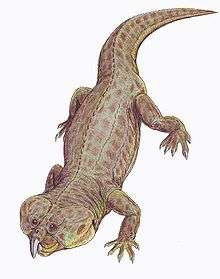Noteosuchus
| Noteosuchus Temporal range: Early Triassic, Induan | |
|---|---|
| Scientific classification | |
| Kingdom: | Animalia |
| Phylum: | Chordata |
| Class: | Reptilia |
| Order: | †Rhynchosauria |
| Genus: | †Noteosuchus Broom, 1925 |
| Type species | |
| †Eosuchus colletti Watson, 1912 | |
Noteosuchus is an extinct genus of basal rhynchosaur known from the earliest Triassic deposits of Eastern Cape Province, South Africa. It was first named by David Meredith Seares Watson in 1912 and the type species is Eosuchus colletti.[1][2] The generic name Eosuchus is preoccupied by the generic name of Eosuchus lerichei Dollo, 1907, a gavialoid crocodilian known from northern France.[2][3] Thus, an alternative generic name, Noteosuchus, was proposed by Robert Broom in 1925. The generic name erected by Broom (1925) is a compound, meaning "Not Eosuchus",[1] while "Eosuchus" is derived from the name of Eos, the goddess of the dawn in Greek mythology, and suchus, Latinized from the Greek souchos, an Egyptian crocodile god, thus meaning "dawn crocodile". The specific name, colletti, honors Mr. Collett for the discovery of the holotype and only known specimen.[2]
Noteosuchus is known solely from the holotype AM 3591, a well-preserved partial postcranial skeleton currently housed at the Albany Museum, South Africa. It was collected from a hill slope at Grassy Ridge locality, from the Katberg Formation of the Beaufort Group. This horizon belongs to the Lystrosaurus Assemblage Zone, dating to the early Induan stage of the Early Triassic period. Thus, Noteosuchus represents the geologically oldest known rhynchosaur species.[1][2][4][5]
David M. Dilkes (1998) suggested that Noteosuchus colletti may be a junior synonym of Mesosuchus browni, and thus this species has been widely ignored since.[6] However, Ezcurra, Scheyer and Butler (2014) noted that this synonymy was based only on generalized rhynchosaur plesiomorphic similarities rather than autapomorphies. They found this to be unlikely because the temporal gap between the two species spans most of the Early Triassic, as Mesosuchus is otherwise known only from the Middle Triassic. Additionally, their phylogenetic analysis recovered Noteosuchus and Mesosuchus in a polytomy with Howesia browni, a result which is inconsistent with such synonymy.[5]
References
- 1 2 3 David Meredith Seares Watson (1912). "Eosuchus colletti, gen. et spec. nov". Records of the Albany Museum. 2: 298–299.
- 1 2 3 4 Robert Broom (1925). "On the South African rhynchocephaloid reptile "Eosuchus" colletti, Watson". Records of the Albany Museum. 3: 300–306.
- ↑ Delfino, M., Piras, P., and Smith, T. (2005). "Anatomy and phylogeny of the gavialoid crocodylian Eosuchus lerichei from the Paleocene of Europe". Acta Palaeontologica Polonica. 50 (3): 565–580.
- ↑ Robert L. Carroll (1976). "Noteosuchus — the oldest known rhynchosaur". Annals of the South African Museum. 72 (3): 37–57.
- 1 2 Ezcurra, M. N. D.; Scheyer, T. M.; Butler, R. J. (2014). "The Origin and Early Evolution of Sauria: Reassessing the Permian Saurian Fossil Record and the Timing of the Crocodile-Lizard Divergence". PLoS ONE. 9 (2): e89165. doi:10.1371/journal.pone.0089165.
- ↑ David M. Dilkes (1998). "The Early Triassic rhynchosaur Mesosuchus browni and the interrelationships of basal archosauromorph reptiles". Philosophical Transactions of the Royal Society of London, Series B. 353: 501–541. doi:10.1098/rstb.1998.0225.


